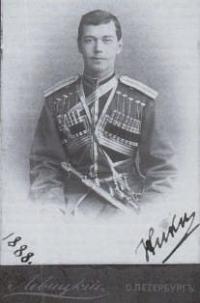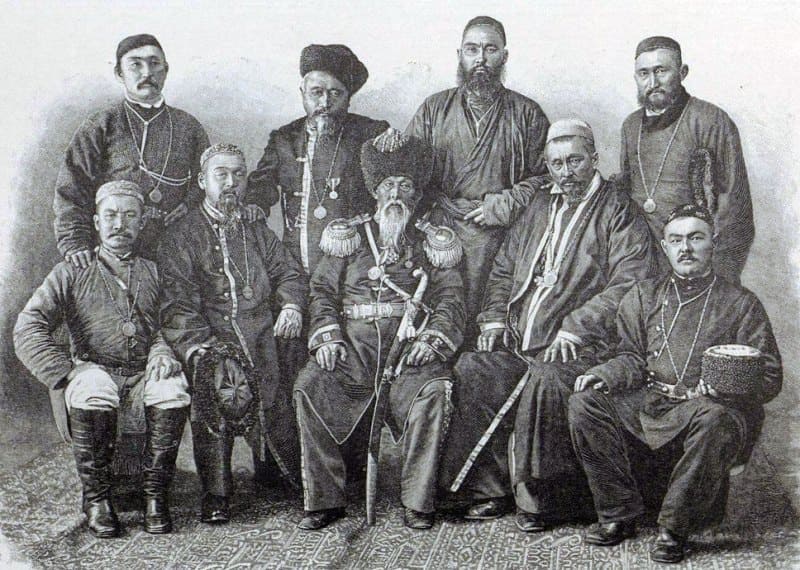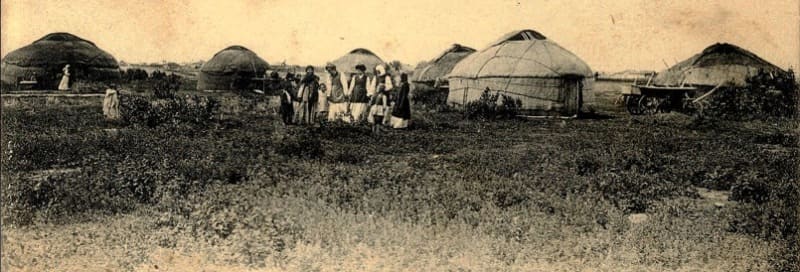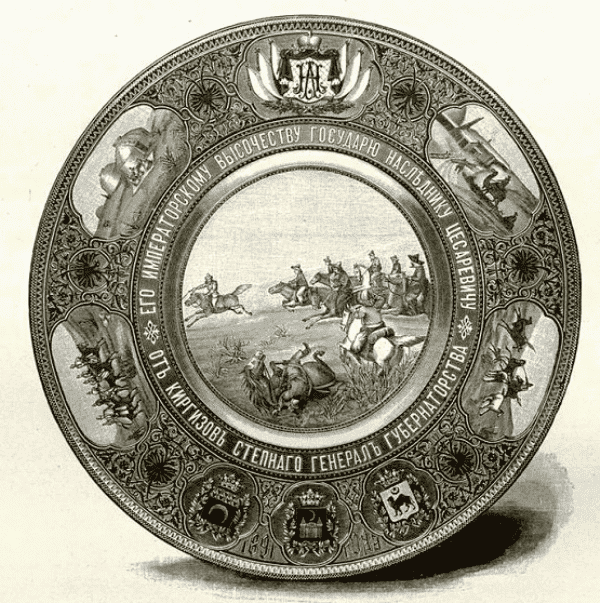You are here
Tsarevich Nikolai Romanov in a Kazakh village.

Travels through steppes of Kazakhstan.
“In the year ninety-one, the news spread among the people,
That the Tsar's son Nicholas will visit our Steppe region,
What will he look at the villages, the dashing Cossacks in the bright room.
Soon the army received an order that they wanted to see us
Our dear Ataman, the young Tsarevich.”
A song about the trip of the Tsarevich (the song was recorded from the words of a Cossack woman by Sergei Vinichenko. “He flew through the villages, wanted to see everything everywhere,” “Arguments and Facts. Kazakhstan” No. 4, 2005.
History of Kazakh steppe.
In 1891, His Imperial Highness the Sovereign, the heir, Tsarevich Nikolai Alexandrovich, made a large study tour of the Russian Empire. The cities visited included Omsk and a Kazakh village on the banks of the Irtysh.
Steppe Governor-General M.A. Taube instructed statisticians, experts in Kazakh life, I.A. Kozlov and V.K. Gern to prepare the meeting program, who turned to the village elders and the most respected biys in the Steppe.
For almost six months we were organizing an aul on the banks of the Irtysh, 12 versts from Omsk. A steppe felt town of 20 yurts, filled with household items of the poor, middle and rich classes, grew up there. The yurts, located five together, were placed in a semicircle 40 meters from the gazebo.
They were separated by two of the largest and most elaborately decorated tented guest yurts. At some distance from the yurts and gazebos, light summer rooms were erected, also made of felt, in which Kazakhs from all over the Steppe gathered.
Improviser singers, wrestlers and healers-bakhsy showed their skills here. The fires were burning, the steppe people were getting ready, the sheep were grazing. Tsarevich Nikolai, accompanied by his retinue, arrived on the steamship Nikolai on July 15.
Representatives of the Kazakh Steppe met him at the pier. The most respected elders - Chingiz Valikhanov (Akmola region), Islyam Alikhanov (Semipalatinsk region) and Sultan Naimankhanov (Semirechensk region) - presented the Heir with a gilded dish, on which, among images of baiga, horse catching, summer and wintering, everyday scenes, were the guest’s initials - “ N. A." - and the coats of arms of the three regions.
On the platter there was a golden bowl-yurt filled with kumys, covered with a silver lid - shanyrak. Vali-Akhun and Ma-Chan, representatives of the Dungans and Taranches, presented bread, salt, Indian brocade and an address on a dish made of Chinese porcelain.
These two most honorable groups stood to the right of the gangway. The left rank consisted only of Kazakhs: officials, students of educational institutions, high school students, people of different classes.
The future Emperor began his inspection:
- from the yurt of the famous rich man of Akmola district Nurmukhamet Saganaev. There were expensive colored cloths, a bed with a satin canopy, and girls in saukele headdresses doing handicrafts. The guest was told what “saba” with kumys is, how sheep, mares, and camels are milked and steppe cheese is prepared: kurt and rymshik.
- The second yurt belonged to Meiran Shanaidarov from Atbasar district. It displayed authentic items granted on May 27, 1782 by Empress Catherine II to the Khan of the Middle Horde, Vali. Among them are a robe, a sable fur coat, a brocade belt, and a saber decorated with precious stones. Here the Heir was treated to traditional besbarmak.
- In the next yurt, visitors were met by a Kazakh from Omsk district, Tastambek Chunaev, who represented the Kazakh population of the outskirts of Omsk.
- The fourth yurt was prepared by the Kazakhs of the Petropavlovsk district on the theme “Steppe hunting”. In addition to the various types of hunting traps and guns presented in it, fox, saiga antelope, golden eagle and hawk were put on display in cages.
- In the fifth yurt, products of steppe artisans were exhibited. The craftsmen who were here, from among the zergers, carpenters, mechanics, and blacksmiths, prepared elegant and original items on the steppe theme. The prince accepted everything proposed.
- Chingiz Valikhanov, the owner of the sixth yurt, gathered musicians, singers, and poets. Cui played dombra and kobuz, and odes were improvised in honor of the guests. “In the seventh, poor peasant’s yurt, everything corresponded to the life of nomadic shepherds. Smoky felt, dung, teapot, jug, cast iron. The food is the simplest of leather and fried wheat, brick tea in a teapot.
- Having made the inhabitants of this yurt happy with the attention, the Tsarevich moved to the next one, to the volost manager of the Terenkul volost of the Pavlodar district, Ilyas Shankarin. The room was occupied by the archaeological collections of the Semipalatinsk Regional Statistical Committee.
- The “Geology” section was assigned the ninth yurt. Most of the minerals belonged to Pavlodar resident A.I. Derov and Karkaraly resident S.A. Popov.
- In the tenth yurt the products of handicraftsmen and students of Pavlodar, Zaisan and Karkaraly agricultural schools were concentrated. The precision of finishing of the product of the Baibosunov family from Karkaralinsk attracted attention. The Tsarevich became interested in a folding table, convenient for travel.
In the two remaining large yurts, the Tsarevich was presented with gifts. The Kazakhs of Pavlodar district succeeded the most. Sadvokas Musin Chormanov (Akmola volost) presented “a Sivan type saddle with silver decorations.”
Isa Berdalin (Altybaevskaya volost) surprised with a wooden aybolt, in the handle of which a steel dagger was hidden. Khusain Bochtaev presented a leather belt and a bag - “kse” with silver trim, Bastemiy Tatenev (Marelda volost) - a hawk trained for hunting.
The governor of the Sarysu volost of the Atbasar district, Kalmambet Bayrauletov, donated a tiger skin. The already mentioned Nurmukhamet Saganaev prepared the skin of a young leopard, a battle ax and an “ala-balen” - a clothes hanger.
Two volost governors presented gifts from the Semipalatinsk region. From the Seitenovskaya volost Temirgali Norkenov - a “Karakeitsky saddle”, from the Belgash volost Aitkozy Zhaksenev - a richly decorated wooden bed.
The guest and his retinue, located in the gazebo, were shown the migration of the Kazakh village. First we went to the village of a young family. On the front camel there was a so-called “karagul”, decorated with bells and pheasant feathers.
The horses were of the best breeds, the clothes of the village residents were decorated with patterns, and songs were sung. The rich “cache” was followed by the poor “cache” on two carts. Two-wheeled, creaking carts were pulled by oxen and cows. The nomads themselves sat on the bulls.
At five in the evening the Heir and his retinue departed for Omsk amid loud cries of “Hurray.” The Kazakh village was also deserted. The men rushed after on horseback. Grand races were coming up at the racetrack of the Society of Trustees of Horse Racing.
53 horses were entered for the race, mostly of the Kazakh steppe breed. The races were held in two categories - 10 and 3 versts. The main prize - a gold watch with a chain - was received by Meiram Zhanaidarov from His Imperial Highness.
He received a silver cup holder for third place in another nomination. The representative of Sary-Arka from the Nelda volost, Mustafa Zhanibekov, became the owner of a silver dish worth one hundred rubles. At the races, the jockeys were usually teenagers. They, as prize-winners, received a gold semi-imperial, which made them delighted.
After the royal personage left Omsk, the Governor-General awarded the most distinguished and energetic assistants. Let me briefly list their names. From Omsk district - Kenzhebay Ordabaev, Khasen Kakenov and Tastambek Chunaev, from Pavlodar district - Ilyas Shankarin and Musrali Zhanturin, from Semipalatinsk district - Gali Akpasov, Asylkhan Tabuldin, Akhmet Omarov, Bektemir Chunaev.
The Sovereign Emperor, by his decision, awarded the following volost elders (biys): Isa Berdalin, Khusain Bochtaev and Temirgali Norkenov - silver medals, Aitkozy Zhaksenev, Bastemia Tatenev and Dungan Mazhin Morfu - gold.
The steppe gifts arrived safely with the future Emperor Nicholas II in St. Petersburg. A special museum life began for them, with many interesting stories behind it. Today, the products of distant ancestors, reminding us of themselves, simply appeared to our attention from bygone years.
The socio-political and literary newspaper “Stepnoy Krai” writes about this visit, which was published in Omsk from 1893 to 1905 2-3 times a week, from 1904 - daily. At the beginning of 1893 - “Steppe Leaf”. A radical publication created on the initiative of the political exile former Narodnaya Volya member L.K. Chermak, who managed to turn a previously insignificant piece of paper into a leading provincial newspaper.
“The heir arrived along the Irtysh on the ship “St. Nicholas”. Representatives of the Kazakh Steppe met the heir at the pier. The most respected aksakals handed him a gilded dish, on which, among images of baiga, horse catching, summer and winter camps, and everyday scenes, were the guest’s initials - “N.A.” - and the coats of arms of the three regions.
On the platter there was a golden bowl-yurt filled with kumys, covered with a silver lid - shanyrak. Representatives of the Dungans and Taranches presented it on a Chinese platter porcelain bread, salt, Indian brocade and address...
The two most honorable groups stood to the right of the gangway. The left rank consisted only of Kazakhs: officials, students of educational institutions, high school students, people of different classes. The Tsarevich honored with a visit to the scientific and educational departments of the exhibition in the Kyrgyz village...
The Peter and Paul district was represented by a yurt on the theme “Steppe Hunting”... This beautiful large yurt was superior to many others with a very well and durable made and painted wooden frame. On one side, on the right, it was hung along the wall with various rich Kyrgyz clothes and furnished with ancient kumyz dishes (as in the text), made from birch root.
On the other, left side, objects and methods of Kyrgyz hunting were presented. Here hung the skins of animals hunted by the Kirghiz of the vast Steppe General Government: the skins of leopards, lynxes, foxes, argali, deer, wolves and other animals completely covered the left half of the walls of this yurt.
In addition, there were live young fox and young antelope, saiga (in Kyrgyz kiik, or bukone). The latter is especially interesting because saiga rarely tolerates captivity, and this small specimen is already readily nibbling grass, so there is a possibility of raising it.
Golden eagles with caps, hawks, matchlock and other guns and traps of Kyrgyz work were presented as hunting methods. In the same yurt there was a place for a Kyrgyz woman with a loom, busy weaving Armenian fabric, and a patternmaker, busy with cutting cloth and fabrics to decorate the yurt with kosh (tyus-kiyz), braids, etc.
The Tsarevich deigned to inspect a model of the farm of the Peter and Paul Agricultural School, made by students of this school. Chingiz Valikhanov, the owner of the sixth yurt, gathered musicians, singers, and poets.
The kyuis were played on the dombra and kobuz, and odes were improvised in honor of the guests.” In the seventh, poor peasant's yurt, everything corresponded to the life of nomadic shepherds. Smoky felt, dung, teapot, jug, cast iron.
The food is very simple: roasted wheat leather, brick tea in a teapot. Of course, at almost every yurt, guests were greeted by “beautiful Kyrgyz women in colorful national costumes and tall headdresses with feathers.”



Authority and photos:
Yu. G. Popov. Local historian, honorary citizen of the Karkaraly region of the Republic of Kazakhstan.
“Bayan-Aul pages” 1826 – 2006 Saint Petersburg. 2006
https://web.archive.org/web/20160305125038/http://torgprice.ru/post/1000/27/53465.php
http://www.torgprice.ru/
http://kostanay1879.ru/index.php?option=com_content&task=view&id=1093






